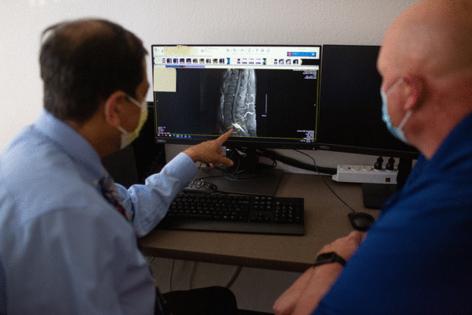Valley fever cases are expected to spike in California. Here's how to avoid it
Published in News & Features
LOS ANGELES — For the second year in a row, California is on track to have a record-breaking number of valley fever cases, which public health officials say are driven by longer, drier summers.
There have been more than 4,000 cases of valley fever reported statewide from January to April, an increase of more than 3,000 cases compared with the same period in 2024 and 2,000 more cases than in 2023, according to the California Department of Public Health.
Last year’s recording breaking number of cases reached a total of 12,605; in 2023 there were more than 9,000 cases.
Valley fever, or coccidioidomycosis, is a lung infection that people get when they breathe in spores of the fungus, coccidioides, that lives in dry soil, according to the Centers for Disease Control and Prevention.
Spores of the fungus that grow in the dry soil are released into the air when the soil is disturbed by wind, construction and other activities.
The fungus is found in the Pacific Northwest and Southwest United States, parts of Mexico, Central America and South America.
Last year in Kern County, the music festival Lightning in a Bottle became a hot spot for the disease after 19 people reported contracting valley fever, with several people experiencing severe symptoms, including pneumonia-like conditions, rashes, headaches and exhaustion.
Valley fever cases commonly increase statewide in late summer and decline in the winter, however state public health officials say the onset of valley fever transmission is starting earlier and lasting longer.
UC Berkeley researchers say climate change is expected to lead to drier spring and fall seasons and heavier winter rains. The prolonged dry seasons can extend the periods of high-risk exposure to valley fever.
Valley fever is often misdiagnosed because the symptoms (cough, fever and chest pains) are similar to other infectious diseases, which can make it difficult for health officials to accurately report the number of cases.
The number of valley fever cases so far this year is trending toward a new record but public health officials say it’s still too early in the year to determine whether this will be a record breaker.
Here are some precautions to help locals, hikers and tourists in counties with high numbers of reported valley fever cases to avoid the disease this summer.
How to protect yourself from contracting valley fever
Public health officials in Fresno County, which includes a section of the John Muir Trail, share the following cautionary tips for hikers:
—Stay on well-maintained trails and avoid activities that kick up dust such as digging or biking off-path.
—Consider wearing a properly fitted N95 mask when hiking in dusty or dry conditions.
—Avoid hiking during windy days or right after a disturbance that may increase dust in the air.
—Clean any skin wounds well with soap and water, especially if they have been exposed to soil or dust.
For anyone who lives, works or travels in an area where valley fever fungus grows, the CDC recommends:
—Stay indoors when it’s windy outside and the air is dusty.
—On windy days, keep windows and doors closed to prevent dust and possible spores from entering the home.
—When driving through a dusty area, keep car windows closed and use recirculating air, if possible.
—Before digging, wet down soil and dirt to prevent stirring up dust into the air.
—Consider wearing a properly fitted N95 mask if you must be in dusty air outdoors in these areas.
Who is at risk of contracting valley fever
Those who spend a lot of time outdoors and are exposed to dirt and dust in areas where valley fever is common are more likely to contract the disease, according to the Los Angeles County Department of Public Health. That includes construction workers, farmers, military workers and archaeologists.
People who live and work near dry and dusty areas are also at risk of being exposed to valley fever.
People who have an increased risk of contracting the disease include:
—Adults 60 years and older.
—Those who have diabetes or health conditions that weaken the immune system, which include cancer, HIV, autoimmune illnesses, those with an organ transplant or who are receiving chemotherapy or steroids.
—Pregnant women, especially those in the later stages of pregnancy.
—Children who are 5 years old and younger.
—Those who are of Black, Latino, Native American or Filipino decent, although experts say they don’t have a clear answer on why these groups of people are more susceptible.
What are the symptoms of valley fever
The fungus infects the lungs and can cause respiratory symptoms that include cough, fever, chest pain, fatigue, difficulty breathing, muscle or joint pain, night sweats, weight loss or rash.
While Valley fever shares many of the same symptoms as other respiratory diseases, including COVID-19, it takes about one to three weeks for valley fever symptoms to develop, and the illness can last a month or more.
Some people with valley fever may experience only mild symptoms that get better in a few weeks so treatment won’t be necessary, according to Los Angeles County public health officials.
However, there are others who will have symptoms that last a month or longer and may need treatment depending on their doctor’s consultation.
In rare severe cases, the disease can spread from the lungs to other parts of the body.
The disease is usually diagnosed with a blood test.
If you test negative for COVID-19 and have respiratory symptoms that last more than a week, and live in or have recently traveled to an area where valley fever is more common, public health officials suggest you talk to a doctor.
Because valley fever affects each person differently, treatment will be determined based on the severity of the disease. The disease is often treated with antifungal medications.
_____
©2025 Los Angeles Times. Visit at latimes.com. Distributed by Tribune Content Agency, LLC.







Comments